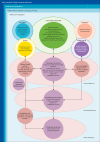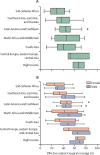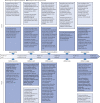The Lancet Global Health Commission on Global Eye Health: vision beyond 2020
- PMID: 33607016
- PMCID: PMC7966694
- DOI: 10.1016/S2214-109X(20)30488-5
The Lancet Global Health Commission on Global Eye Health: vision beyond 2020
Figures























Comment in
-
Ageing and vision loss: looking to the future.Lancet Glob Health. 2021 Apr;9(4):e385-e386. doi: 10.1016/S2214-109X(21)00031-0. Epub 2021 Feb 16. Lancet Glob Health. 2021. PMID: 33607013 No abstract available.
-
Eye health and the Decade of Action for the Sustainable Development Goals.Lancet Glob Health. 2021 Apr;9(4):e383-e384. doi: 10.1016/S2214-109X(21)00035-8. Epub 2021 Feb 16. Lancet Glob Health. 2021. PMID: 33607014 No abstract available.
-
Lessons from 2020 for equity in global eye health.Lancet Glob Health. 2021 Apr;9(4):e387-e388. doi: 10.1016/S2214-109X(21)00036-X. Epub 2021 Feb 16. Lancet Glob Health. 2021. PMID: 33607017 No abstract available.
-
Visual function rather than visual acuity.Lancet Glob Health. 2021 Jul;9(7):e913. doi: 10.1016/S2214-109X(21)00225-4. Lancet Glob Health. 2021. PMID: 34143992 No abstract available.
-
Visual function rather than visual acuity - Authors' reply.Lancet Glob Health. 2021 Jul;9(7):e914. doi: 10.1016/S2214-109X(21)00246-1. Lancet Glob Health. 2021. PMID: 34143993 No abstract available.
-
Madras eye outbreak in India: Why should we foster a better understanding of acute conjunctivitis?Indian J Ophthalmol. 2023 May;71(5):2298-2299. doi: 10.4103/IJO.IJO_3317_22. Indian J Ophthalmol. 2023. PMID: 37202982 Free PMC article. No abstract available.
References
-
- GBD 2019 Blindness and Vision Impairment Collaborators. on behalf of the Vision Loss Expert Group of the Global Burden of Disease Study (VLEG–GBD) Trends in prevalence of blindness and distance and near vision impairment over 30 years: an analysis for the Global Burden of Disease Study. Lancet Glob Health. 2021;9:e130–e143. - PMC - PubMed
-
- WHO World report on vision. 2019. https://www.who.int/publications/i/item/world-report-on-vision
-
- WHO Framework on integrated people-centred health services. 2016. https://apps.who.int/gb/ebwha/pdf_files/WHA69/A69_39-en.pdf?ua=1&ua=1
-
- WHO ICD-11 for mortality and morbidity statistics (version: 04/2019)—9D90 vision impairment including blindness. 2019. https://icd.who.int/browse11/l-m/en#/http%3a%2f%2fid.who.int%2ficd%2fent...
Publication types
MeSH terms
Grants and funding
LinkOut - more resources
Full Text Sources
Other Literature Sources
Medical

